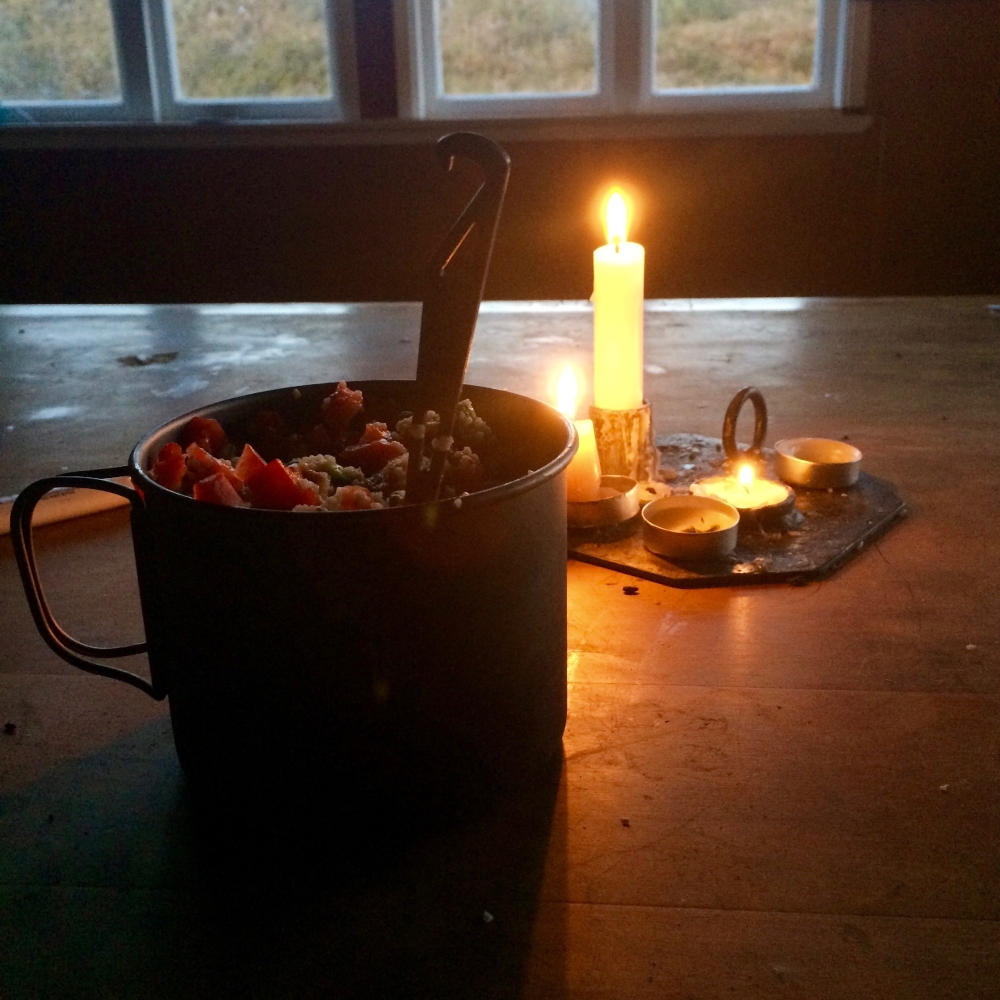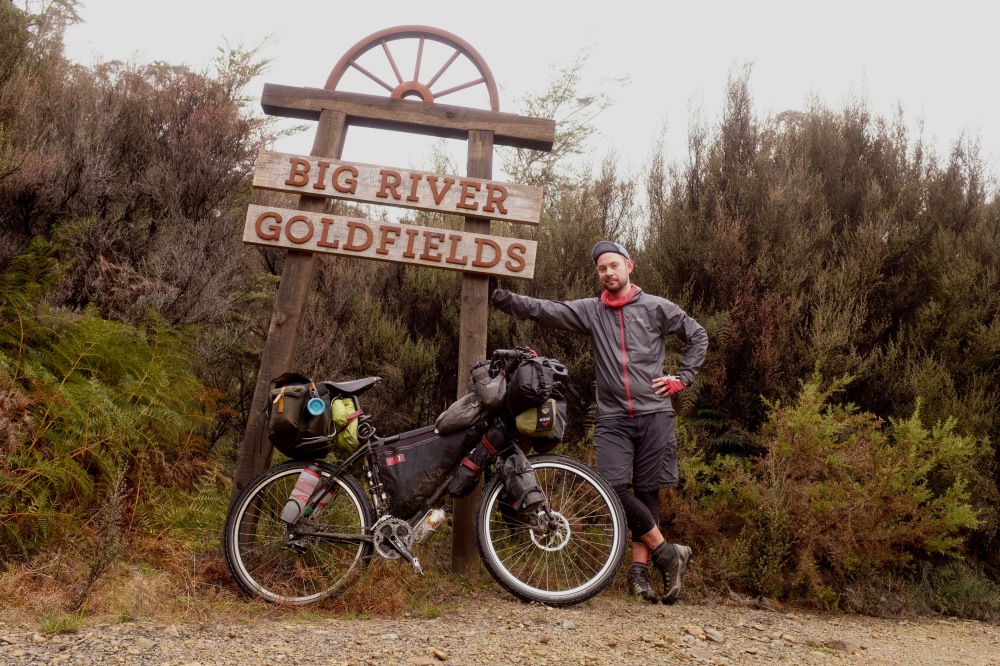I’m standing at a junction. I have two options, two directions that I can point my bike down and start pedalling. Each would take me to Reefton but each offers a remarkably different journey there.
To my left is the main road: smooth, sealed bitumen that has a shoulder on the side that’s surprisingly generous for a road in New Zealand. It’s the type of road you can put in your headphones and smash out some distance. It’s ideal for ‘getting there.’



To my right is the scenic route, the feral cousin of the well groomed main road. This route would take me through abandoned mining towns, along old bridleways and singletrack; it would take me far away from any civilisation, convenience, phone signal, comfort, or the ability to get anywhere quickly or easily. Last night I searched the Big River Track on Instagram and all I found were an ominous bunch of pictures of angry, muddy people pushing their bikes.
I’m standing at that junction and that trope you see on TV comes to mind, the one when a character has some moral dilemma to solve and little angel and devil versions of themselves pop into the air to help flush out the argument. I imagined how the little incarnations of myself would appear at this moment. The one on my left looks quite content with life. His skin is red, there’s one of those little towels you get in an onsen still resting on his head and he’s uncharacteristically clean for someone on a bike tour. He takes a swig from his tin of Sapporo Beer and points out that since I’m going to Reefton anyway and have limited food, I might as well just get the journey over and done with, enjoy a rest day, and finish that series of Peaky Blinders that’s on my laptop from beneath a duvet. Everyone, meet Japan Nick.
The guy on my right couldn’t disagree enough, although I feel a little concerned for his dishevelled appearance. His eyes look tired, the black bags under them betray another night’s sleep robbed by food poisoning and the panicked fumbling of zips to get out of his tent and find the loo roll in time for the next wave of diarrheic hell. Yet, behind the fatigue, there’s an enigmatic sparkle of excitement in his gaze. His clothes are dirty and hanging slightly loose from an unfulfilling diet of stale bread, watery porridge, and tinned Russian fish. Meet Tajikistan Nick. It’ll be an adventure, he says. It’ll be a story to tell, he says. He goes on to argue that if I wanted to get anywhere quickly, why the hell did I get on a bloody pushbike.
Tajikistan Nick won the argument. I turned right.
The decision takes me up onto the Big River Track and the first port of call was the ghost town Waiuta. All that’s left are rusting smoke stacks, and “danger: mine shaft” to tell you what brought people here and what’s demise led to the town’s disappearance. More gold came out of that hole than any other on the West Coast and the information boards show a vibrant community the workers created: they even built a bowls club built on the slag heap. When the main shaft collapsed, the mine, the town’s sole employer, eventually shut down and the town emptied in a matter of months. The houses have mostly disappeared but what remains, other than the stone fireplaces, are the gardens. The neatly demarcated lines of European plants dotted all over the town are more a legacy of the town’s inhabitants than the crumbling buildings; the latter will eventually disappear completely but the plants have flourished to near plague levels. Come to New Zealand and it won’t be long before you become acutely aware of man’s meddling with nature and the struggle between domestic and imported species. Eighty percent of indigenous birds are in some way threatened, whereas any forest walk you take will inevitably take you through a literal minefield of rat and stoat traps attempting to hold back the infestation.



After Waiuta the road degenerates into the old track used my men and horses through a dark beech forest in which any branch or trunk of the trees was covered in moss. The ubiquitous moss testifies to how much rain falls on the We(s)t coast of New Zealand, but so did the mud. My wheels don’t like the mud; I’m thrown off the bike, I shout four letter words and get off and push for a while, a long while. My confidence isn’t great, this being the first time riding on singletrack that on one side, through a thick curtain of fern leafs, is a drop long enough to keep me off the saddle and keep me pushing the bike over slippery roots. Someone really took poetic license with their definition of a track a while later, when I end up pushing my bike down a flowing creek bed.





Standing there in my wet shoes, I curse Tajik Nick, but it wasn’t long before I came to understand that sparkle I saw in his eyes. Eventually there were moments, interspersed by the pushing, of pure delight on the saddle, where work had been done on the track and shingle or wood chipping gave me enough traction to ride. To be here – in stunning wilderness, on a bike and far away from civilisation – was glorious. I didn’t even entertain the idea of reaching for my headphones, a temptation that all too often pops up while rumbling along the while lines of a road’s shoulder. Late in the afternoon I made it through the forest and arrived at Big River Hut, where I’d spend the night enjoying four walls and a roof for shelter and a well stocked coal stove for warmth. One of my favourite things about New Zealand is that if you want to go out into the middle of nowhere, the Department of Conservation provides you with some pretty luxurious accommodation for when you get there. Well, it certainly beats a tent.

Another few hours of riding the next day through another dose of mud and thick, disorientating forest and I arrive in Reefton, the place I could have been in a few hours if I had turned left and stayed on the main road. If I took the main road I’d have just gotten there and I would have had nothing to say for it except for the fact that I’d gotten there quickly. Instead, I arrive in Reefton dirty, tired, and with a smile on my face brought about with pride in a sense of achievement that I managed to do my first bit of single track ‘bikepacking’ without too many embarrassing falls.
Some people call this sort of thing type two fun, something that’s only fun in hindsight, when you’ve ran out of swear words and returned to civilisation. The sense of achievement you get afterwards gives it a rose tinted perspective as the difficulty is pushed into into some black hole by your mind’s selective amnesia. That’s why after three months in Japan, while I had a great time in an amazing country, I felt something was lacking in the experience of it and why Tajikistan, with all its discomfort, illness, difficulty at the time, is one of the places I look back on so dearly. It was amazing but also challenging.
In spite of all this, in spite of knowing how good and rewarding type two fun feels after the event, making the decision to take the difficult path still proves difficult to do. After three years on the road, I have normalised an average day of pedalling on roads; it’s sort of become my comfort zone. Breaking out of it, whether you’re living a normal life and beginning a trip or whether you’ve spent a few years cycling around the world, still proves to be a challenge.
The observant amongst you may notice the bike looks a bit different. I’ve ditched the panniers and a lot of gear go lightweight for the precise reason to explore more interesting places and routes than following the bigger lines on a road map. The Big River Track was my first experience at this and my first lesson in so-called ‘backpacking’ is that, even though you might have the gear, it still requires a little bit of willpower to get off the beaten track.


A few days later I stood at another junction and had this choice all over again. Tajikistan Nick thankfully won the argument which led to another great deal of pushing and swearing on the Muangatapu track.
It was great fun. Afterwards, anyway.

I love reading your blogs! Another great tale of adventure! There is, of course, Type Three Fun which is reading all about SOMEBODY ELSE doing wet, muddy, strenuous adventure,while you are sipping a gin and tonic in a comfy armchair.
Your photos are as brilliant as ever. Regarding your new lightweight packing …. isn’t there just as much ‘stuff’ but it’s all a bit higher up on the bike?! But I believe you, really I do. It all looks ridiculously small for a trip around the world. I take more than that going shopping. But I suppose you don’t have the dilemma of: “Oh, what SHALL I wear today?”! Or: “What shall I eat?” Hope the oysters are just as good as Tasmania’s! Keep pedalling – and writing about it for us Type Threes!
LikeLiked by 1 person
Haha yes, there’s never any fashion dilemmas for me, other than this is starting to smell too bad. Although I’ve shed a lot of gear, I am still carrying quite a bit of stuff compared to those who go out of a weekend ride; I still need everything for 4 seasons. That said, it’s considerably lighter than my previous setup, which makes me wonder what on earth was I carrying before hand?
LikeLike
Haha, some nice notions: type two fun and Japan Nick vs Tajik Nick. Keep it up 😊
LikeLiked by 1 person
Thanks, Vera! Unfortunately I can’t claim type tow fun as my own.
LikeLike
Amazing pictures Nick, what an interesting ride keep peddling love Mum xxx
LikeLiked by 1 person
Type 2 fun, I like that! Excellent read.
LikeLiked by 1 person